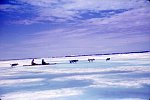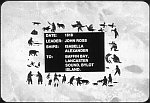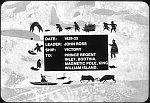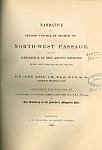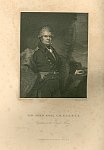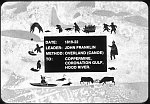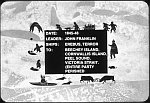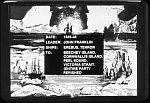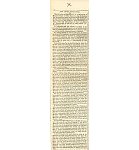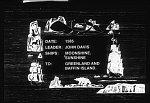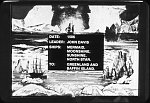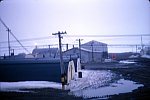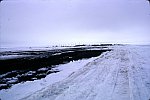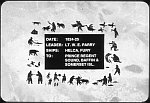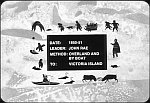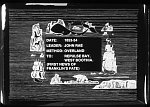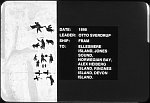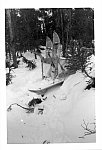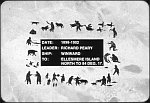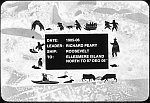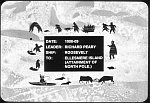Explorers and Northern Exploration
Author: Anne Mease Page 1 | Page 2 | Page 3
Sir John Ross (1777-1856)
Sir John Ross was born in 1777 in Balsaroch, Scotland. Ross became an expert seaman at the age of nine when he entered the 'Royal Navy.' On July 3,1818, Ross sailed on the Isabella and Alexander as the leader of the expedition in search of the Northwest Passage. Lieutenant William Parry was aboard this expedition.
Sir John Ross got his first glimpse of the Inuit and their sledges as they docked on Melville Bay. The Inuit were hesitant to approach the ships amid gifts and tokens that Ross used to entice the Inuit closer. They erected a pole with "a bag containing presents, with a device of a hand painted on it."[21] Ross had along with him, John Sackheuse, an Inuit from Greenland who acted as interpreter and guide. Having Sackheuse along was fortunate for Ross because the Inuit did not want strangers in their territory and violence may have erupted had he not been there to interpret their requests. Ross presented the Inuit with mirrors and apparently, "their astonishment appeared extreme delight, as well as surprise."[22]
They reached a latitude of '75� 12' and 76�' in a place Ross named Melville's Monument, now Melville's Bay. At latitude 76� 54' N, Ross "concluded that Lancaster Sound was enclosed by mountains and thus provided no western outlet" [23] and turned southwest to return home. William Parry, did not agree with Ross and would successfully discredit Ross by heading an expedition beyond Lancaster Sound in 1820.
Ross' first Arctic expedition was not all a failure as thought by many for he 'discovered' and mapped out Carey's Island and Cape York before he returned to England.
In 1829, Ross was partially financed by Felix Booth to further explore the same area he had miscalculated years earlier. He left the Thames on June 14, 1829 on the Victory. They sailed past Greenland and into Lancaster Sound. There they found the remnants of Parry's ship the Fury that had been abandoned four years earlier. Their find provided them with provisions they anticipated needing.
They sailed into places Ross named Port Logan, the Boothia Peninsula (after his friend, Felix Booth, the distiller), the Gulf of Boothia, and King William Island. They were forced to winter over half way down the Boothia Bay at a place Ross called Felix Harbour. Their wintering over turned into four winters as they were forced by shipwreck to remain inland.
While stranded, Ross and various members of his crew set out in different directions at different times in search of help or sight of anyone. In the second year they were stranded on June 1, 1832, his nephew, James Ross claimed the Magnetic Pole, at "70� 5' 17" latitude 96� 46' 44" longitude...in the name of H.M. King William IV" [24]
Ross and his crew were picked up by the British ship Isabella, which Ross had been Captain of years earlier. Upon his return to England, Ross was awarded several medals including Knighthood but more importantly, his accomplishment reaffirmed his status in the scientific and geological community he was ousted from years earlier.
In 1850-51 he made his last one journey to Lancaster Sound in a fruitless search of Franklin's expedition. He died a content man in London in 1856.
Sir John Franklin (1786-1847)
John Franklin boarded the HMS Terror and HMS Erebus in 1818 to explore the Northwest Passage under the direction of Sir John Ross. They traveled overland from Hudson Bay to the Coppermine River, NWT between 1918 and 1822 where Franklin was searching to find the mouth of the river to see which ocean it opened into.
On this expedition, Franklin lost "11 of the 20 men in his party." It has been suggested that the crew was starving and those who did not perish from starvation came close to eating each other, linchen, and "their own leather boots," to which Franklin earned the nickname "the man who ate his boots."[25]
In 1826, Sir John Franklin 'discovered' a group of Islands in the Beaufort Sea that lay within the Yukon boundary that he called Herschel Islands, after his good friend John Herschel.
At nearly sixty years of age, Sir John Franklin joined the ranks of other explorers in search of the Northwest Passage in 1845. -
1847 when their ship "became locked in the ice of Victoria Strait off the coast of King William Land," [26] they were forced to winter inland. The sequence of events may never be known but Sir John Franklin and one twenty-eight members of his crew perished from starvation or lead poisoning. Apparently, "the expedition took 8000 tins of food [which were] sealed with lead, which is poisonous."
In 1981, an anthropologist by the name of Owen Beattie found three well preserved bodies in the ice that were believed to be men from Franklin's expedition. A further examination found they had lethal levels of lead in their system that may have accounted for the eventual demise of Franklin and his crew.
At the request of his wife, Lady Jane Franklin, there were various rescue ships sent out over the years to search for Franklin and his crew. Sir John Ross, who Franklin first explored with in 1818 and Robert McClure are among the many who were sent out to search for the missing. Instead, the search for Franklin re-established an interest in Canada's Arctic and a new kind of exploration became evident. 'It was discovered' that natural resources such as furs, diamonds, gold, and copper lay in the frozen Canadian North. These search parties would include some of the greatest geographical and economic discoveries of Canada's North. When the quest for the Northwest Passage seemed an impossible feat, the exploration into Canada shifted towards reaching the geographical North Pole or the True North. While explorers continued to search for the Northwest Passage they found a new endeavor in the new age of geological discovery.
Others who have attempted to be the first to navigate the Northwest Passage include John Davis (1550?-1605) in 1585, 1586, 1587, who "was the first person to draw attention to the sealing and whaling possibilities in Davis Strait and to show that the Newfoundland cod fisheries extended far northwards along the Labrador Coast."[27]
Sir John Barrow (1764 - 1848), of English descent was the
chief investigator of the Northwest Passage in the early 19th Century "argued
that a trans-polar current must exist moving from Bering Strait to Davis Strait."[28] Point Barrow, Alaska was named
after Barrows when Frederick W. Beechey 'discovered' it in 1825.
Sir William Parry (1790-1855) made four expeditions into the Artic searching for the Northwest Passage in 1819-1820, 1821-1823, and 1824-1825. He received the 'farthest North' in 1827 at latitude of 82� 45' N, a record he held for almost fifty years.
John Rae (1813-93) led four expeditions into the Arctic. He is credited for 'discovering' the remains of Franklin's expedition. Over the course of his expeditions, Rae surveyed over 2800 Km of the Arctic coast.
The New Age of Discovery
Otto Sverdrup (1854-1930)
Norwegian explorer Otto Sverdrup (pronounced sver’droop) was born on October 31, 1854 near Bindal, Norway. In 1872 at the age of 17, his Uncle hired Sverdrup as a seaman on his vessels. He attended school and "in 1875 he passed his mate's examination, and some years later the shipmaster's examination."[29]
His first Arctic exploration was in 1888 as part of Dr. Nansen's expedition through Greenland. As a result of this expedition, Sverdrup was hired as Captain of the Fram by Nansen in an attempt to reach the North Pole. Along on this voyage were scientists, artists, and expert seamen. They did not reach the North Pole but in 1895 they did claim for Norway the "furthest north" record at 86� 13' 6" and 95� east.
Sverdrup again sailed on the Fram in 1898 in search of the North Pole but due to massive ice buildup they only made it as far as Canada's Arctic Archipelago.
Sverdrup came across another well-known Arctic explorer by the name of Robert Peary, who was the first person to reach the North Pole. However, Peary was not impressed at finding another explorer in the area that he had 'discovered' and inadvertently misguided Sverdrup in directions.
Sverdrup is credited for the "first exploration and mapping of the south and west coasts of Ellesmere Island, and the discovery and naming of Axel Heiberg Island, the Ringnes Islands, the Sverdrup Islands and many other locations."[30]
Robert E. Peary (1857-1920)
Robert Peary was born in New England in 1856. After graduating from College as a civil engineer, Peary joined the U.S. Navy. Disenchanted with the Navy, he applied for a leave. His quest was to find the North Pole. He had read adventurous stories about those who attempted and failed to reach the North Pole. He did not believe others such as "Sir George Nares [who] had convinced the British public that the Pole was unattainable."[31]
In 1886, Peary took leave from the Navy and sailed to Godhaven, Denmark. There he bought his supplies and was prepared to trek alone until "Christian Maigaard, assistant governor at Ritenbenk, volunteered to accompany him." They were "ferried by Eskimos to the mainland and up a fiord." Form there they went inland with sledges or dog teams. Their expedition lasted three weeks and they made it "...a hundred and twenty miles inland and more than seven thousand feet above sea level..."[32] They returned to Denmark more determined after realizing they would need financial backing, manpower, and experience.
By 1891, Peary had procured the financial and moral support from "scientific and private individuals" and was ready to attempt to find the North Pole again. Peary, along with his faithful friend and servant, Matthew Henson and a crew of scientists and anthropologists among other academics accompanied him for the first part of his endeavor. Seven would carry on with the final trek. It was fortunate for Peary that there was a surgeon along because he broke his leg before they reached their destination.
Peary and his crew built their house and were visited by local inhabitants who were the Arctic Highlander Inuit (Eskimo). He immediately made them allies by putting both the men and women to work. Apparently there were about two hundred Inuit in the vicinity. Upon meeting the Inuit (Eskimo) he described them as 'plump and rounded figures, empathetically expressive countenances, bronze-skinned, keen-eyed, black-maned inhabitants of an icy desert, simple and honest, occasionally sulky; wondering, homeless people; these are my children, the Eskimos.'[33]
Along the way, Peary named the fiord they reached 'Independence Fiord.' Peary and his crew traveled a distance of one thousand miles both ways and his second expedition to the North Pole ended on August 4, 1892. While he did not reach the North Pole, it "was enough to place Peary in the front rank of contemporary discoverers, to him it was only a preliminary move."[34]
With secured financial backing, a ship called the Falcon, a party of ten men and two women; one being his pregnant wife, Peary set sail once more in the hope of being the first to reach the North Pole on August 20, 1893. His daughter was born mainland one month later at Bowdoin Bay where Peary and his wife stayed while his crew set out to map the area.
When the Falcon returned in the spring the three women and a few of the crew returned back to England with it. Peary, Henson, and a young man named Hugh Ross Lee stayed behind to continue on the journey. Peary had planned on trekking as far past Independence Fiord as they could.
The three narrowly escaped death but safely returned home in 1895 without reaching the North Pole. Peary was even more determined to be the first to reach the Pole.
Once again, Peary procured financial backing and in 1898 and was able to make a third attempt to the Pole. Only now he was more determined because another explorer by the name of Otto Sverdrup was also attempting to be the first to reach the Pole. He set sail on the Windward towards Greenland, beyond Cape Summer to Conger where he wintered over. He procured the trust of the local Arctic Highlander Inuit and managed to persuade many families to up heave their camps to travel with him as sledge drivers and hunters.
He set out on foot and sledges on April 5, 1901 to begin his Arctic journey to the Pole. On April 21, 1902, after charting over two hundred miles along the coast of Greenland and at a "latitude of 84� 06' in a hellish tangle of erupted ice blocks and loose snow he gave up...'the game is off...my dream of sixteen years is ended.'[35] He boarded the Winward heading home knowing that if he had been at higher latitude he would have been closer to the Pole and closer to his dream.
Fortunately for Peary there were people such as Morris Jesup and Thomas Hubbard, who believed in his dream as well and provided the finances necessary to undertake another expedition. In July 1905, aboard the very modern ship the Roosevelt, Peary set out with determination to find the North Pole. On April 21, 1906 they reached an latitude of 87� 6'N, but they were still "one hundred and seventy miles from the North Pole."[36] Knowing they were too far east, they turned around but not before mapping out un-chartered territory from "Aldrich's farthest to the northern outlet of Nansen Sound" For this, Peary surpassed Sverdrup as having the 'farthest North record.' After all, he had to provide some kind of evidence that the expedition was warranted.
Peary took a different route home that led him to the northwestern part of Ellsemere Island where they camped, not by choice, but because they lost their ship. In the distance where they were he could see snow capped images that fevered his interest in finding the Pole. On July 6, 1908, Peary, Henson, a group of Inuit, and Captain Bartlett, of the Roosevelt set out once more with final determination to reach the Pole. In reaching an latitude of 87� 48', they were approximately 150 miles from their final destination.
On April 6, 1909 Peary along with his companion Henson and three Inuit named Igginguaq, Sigluk, Odaq, and Ukkaujaaq, they became the first to successfully reach the North Pole. Peary's dream had come true, the North Pole was his "by right of discovery, to be credited to [him]...."[37]
Peary's 'discovery' of the North Pole was contested and unfounded by his crewmember Frederich Cook, who claimed to be the first to reach the Pole. However, recent evidence "indicates that Peary must have been in fact 20 nautical miles (40 km) short of the Pole"[38] and as a result, his competitor, Roald Amundsen and the crew of the Norge are the first verified explorers to have reached the North Pole...in 1926"[39]
Endnotes
[21] D. Murray Smith. Arctic Expeditions From British and Foreign Shores: From the Earliest Times to the Expedition of 1875-76. Thomas C. Jack, Grange Publishing Works, Edinburgh, 1877:90
[22] D. Murray Smith. Arctic Expeditions From British and Foreign Shores: From the Earliest Times to the Expedition of 1875-76. Thomas C. Jack, Grange Publishing Works, Edinburgh, 1877:92
[23] Sir John Ross. Microsoft� Encarta� Online
Encyclopedia 2005
<http://encarta.msn.com> � 1997-2005 Microsoft Corporation
[24] George Malcolm Thomson. The Search for the Northwest Passage. Macmillian Publishing, New York, 1975:227
[25] John Franklin Wikipedia: Free Encyclopedia <http://en.wikipedia.org/wiki/John_Franklin>
[26] Nellis M. Crouse. In Search of the North Pole. Richard R. Smith, New York. 1947:16.
[27] John Davis <http://collections.ic.gc.ca/arctic/explore/davis.htm>
[28] Anne Savours. The Search for the Northwest PassageSt. Martins Press, New York, 1999:44
[29] Explore North-Otto Sverdrup <http://www.explorenorth.com/explorers/sverdrup.html>
[30] Ibid.
[31] L.H. Neatby. Conquest of the Last Frontier. Ohio University, 1966:256,257
[32] Ibid:256
[33] Frank Rasky. Explorers of the North: The Polar Voyagers. McGraw-Hill Ryerson Limited, Toronto. 1976:13.
[34] L.H. Neatby. Conquest of the Last Frontier. Ohio University, 1966:262
[35] Ibid: 276
[36] Ibid: 285
[37] Ibid: 288
[38] Robert Peary Wikipedia: Free Encyclopedia <http://en.wikipedia.org/wiki/Robert_Peary>
[39] Roald Amundsen Wikipedia: Free Encyclopedia <http://en.wikipedia.org/wiki/Roald_Amundsen>
